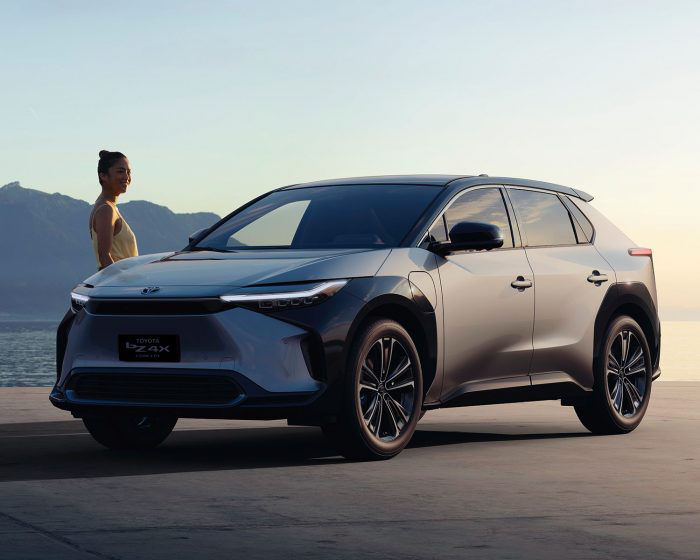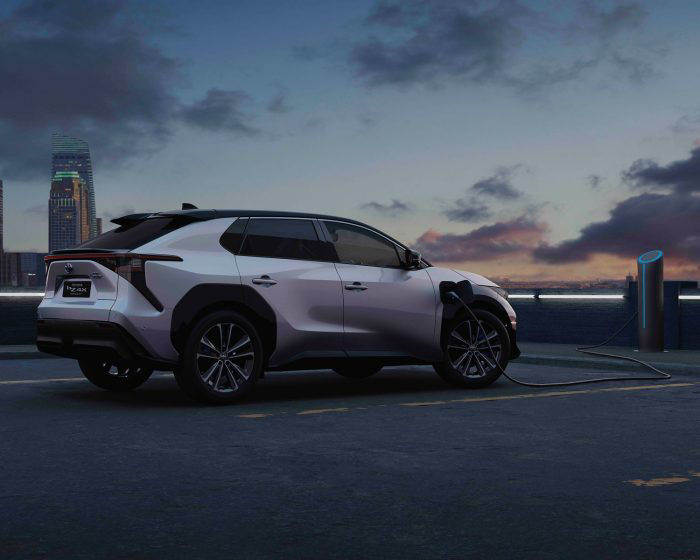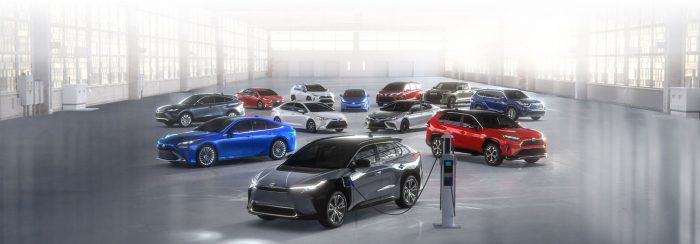Select a province & language
Entrance to this website assumes you have read and agree to these Legal Terms and Conditions and the Privacy Policy.
Entrance to this website assumes you have read and agree to these Legal Terms and Conditions and the Privacy Policy.
How exactly do Battery Electric Vehicles work? The quick answer is pretty straightforward, in theory. However, before we get into the actual nuts and bolts, let’s establish the different types of electrified vehicles we’re talking about.
Toyota’s Electrified lineup is designed to accommodate for every customer lifestyle, that’s why we’re investing in a range of electrified technologies. There are four types of electrified vehicles on the road. Electrified, because they all use an electric motor as a motive force in some way:
Hybrid Electric Vehicles (HEVs) combine two sources of power – a gas engine and electric motor – and automatically choose the best blend of power. The battery recharges on the go, so HEVs never need to be plugged in.
Plug-in Hybrid Electric Vehicles (PHEVs) operate similarly to an HEV, only with a larger battery, providing the ability to travel quicker and further on electric power alone. Unlike a HEV, a PHEV can be plugged in.
Fuel Cell Electric Vehicles (FCEVs) use hydrogen as an energy source to generate electricity onboard, that is then used to power an electric motor or motors. With water vapour as the only tailpipe emission, this electrified vehicle requires no plugging-in, just refills of hydrogen fuel where refueling infrastructure exists.
Battery Electric Vehicles (BEVs) emit no exhaust from the tailpipe and are powered by electricity alone, which is stored in a large onboard battery. All-electric cars must be plugged in to an EV charger to receive a full charge and full range.
Pure Battery Electric Vehicles, or BEVs, are what we’ll focus on in this post.
In place of a gas (internal combustion) engine, Battery Electric Vehicles are powered by an electric motor or motors. These motors are, in turn, powered by electricity that is stored onboard in a large battery pack (more on that in a bit). Because they don’t use gas, electric vehicles produce zero tailpipe emissions. Here’s a closer look at the parts that keep a BEV moving.

The real power behind an electric vehicle is the traction or deep cycle battery. Usually lithium-ion, traction batteries are designed to provide power over a sustained period of time. This is in contrast to a standard 12V battery, which provides a lot of power at once, and usually for a single or limited purpose like starting a car.
The size of the battery is what determines the speed and range an electric vehicle can go on electric power alone. It should come as no surprise that a BEV battery is larger than a PHEV battery -- up to 10 times -- which in turn can be up to 10 times larger than an HEV battery.
Another key factor is the flow of energy from the battery to the motor, and from recharging sources back to the battery. This is known as the charge / discharge cycle. Over time, the number of cycles a battery goes through will impact both battery life and vehicle performance.
A smaller, lighter hybrid battery, for example, might charge / discharge several times on a short errand; and can go through 100,000 or more cycles in its lifetime.
A PHEV battery, with its greater EV speed and range, might go through a cycle once or twice a day, and up to 8,000 or more in its lifetime.
A BEV battery rarely sees a full charge / discharge except on longer journeys, and might see only 1,000 cycles in its lifetime.
Beyond how a battery electric vehicle works, what most people considering buying an electric vehicle want to know is how efficient it is, how far it can go on a single charge, and how long the EV battery will last. To understand all of that, you need to understand some key terms:
Kilowatt (kW)
A watt is a unit of electrical power. A kilowatt (kW) is 1,000 watts and is used to measure the power of the electric motor. Think of it as the equivalent of horsepower (HP), which is the measure of the power of a conventional gas engine.
In fact, you can translate kW into HP by multiplying the kilowatts by 1.34. For example, the Toyota bZ4X LE FWD has a 150 KW engine, which translates into 201 HP.
Kilowatt Hour (kWh)
A kilowatt hour (kWh) is used to measure the capacity of the battery that supplies the electric motor. In other words, it’s the number of watts it can deliver in 1 hour.
There is no one answer to this question. Each BEV will have published figures based on standard tests. For example, the Toyota bZ4X LE model can travel up to 406 km[¹] on a full charge and under ideal conditions.
However, many things in real life driving can affect how long an EV charge will last, including cold weather, how fast you drive, how often you turn on your AC or the heater. All of which can drain the battery faster. As a simple rule of thumb, the larger the battery, the greater the range.

Charging a BEV is simple. Just plug it in. Charging times will vary depending on the type or speed of charging point you are using:
Canada has a growing network of Level 3 fast chargers. The Transport Canada website makes it easy to locate an EV charging station near you.
Batteries for electrified vehicles, including HEVs, PHEVs, FCEVs and BEVs are designed to last the lifetime of the vehicle. At Toyota, BEVs come with an 8-year or 160,000 km Battery and Battery Capacity warranty (whichever comes first) [2]
Toyota goes one step further with its HEV and PHEV batteries, providing a 10-year or 240,000 kms warranty (whichever comes first).
Like every type of electrified vehicle, how an EV fits into each lifestyle might differ from driver to driver, depending on where you live, how you drive, and the uses to which you put your vehicle. Here are a few of each to keep in mind.
The future of electrified vehicles is charging ahead.
This growth is driven by greater consumer acceptance and demand, as well as increasingly stringent government regulations and mandates – both around the world, and here at home. Several provinces, including British Columbia and Quebec have set zero-emission vehicle mandates (ZEV). And federally, Canada continues to be committed to reducing greenhouse gas emissions from all light-duty vehicles.
Our electrification path includes HEVs, PHEVs, BEVs, and Hydrogen Fuel Cell Electric Vehicles (FCEVs). This stems from a belief that there isn’t just one electrified solution that can meet the needs and wants of every customer in every market – and it’s the choice of offerings that will ultimately support us in achieving a more sustainable future.

Furthermore to the above BEV considerations, if you are considering an electrified vehicle of any kind, you can see that a lot goes into that decision. From where you live, to how you drive, to availability of charging stations, and more. To help narrow down your choice, try our Powertrain Quiz. Additionally, take a look at the bZ4X electric SUV and the full range of Toyota electrified vehicle options. There’s sure to be one to meet your needs.
Disclaimers
[¹] NRCan-estimated 406 KM total driving range for bZ4X FWD when vehicle is fully charged and operated under ideal driving conditions. Use for comparison purposes only. Actual range may decrease significantly depending on speed, outside temperature, accessory use, how/where you drive, charging habits, and other factors. Battery capacity also decreases with time and use which will reduce range. See www.nrcan.gc.ca and Owner’s Manual for details.
[2] Whichever comes first. See Owner’s Manual Supplement or ask your Dealer for details.